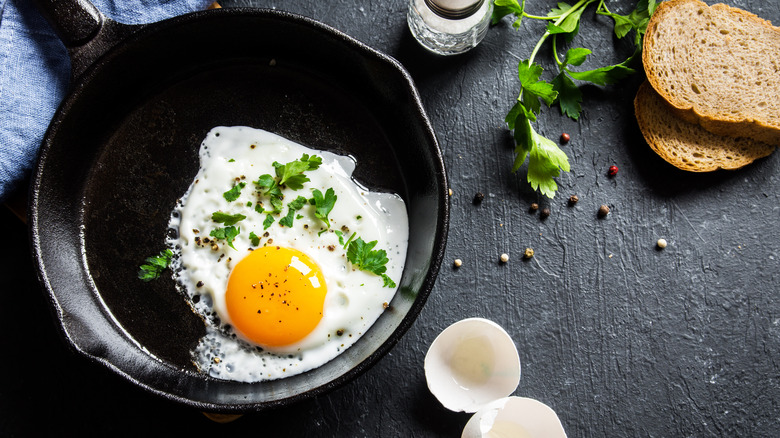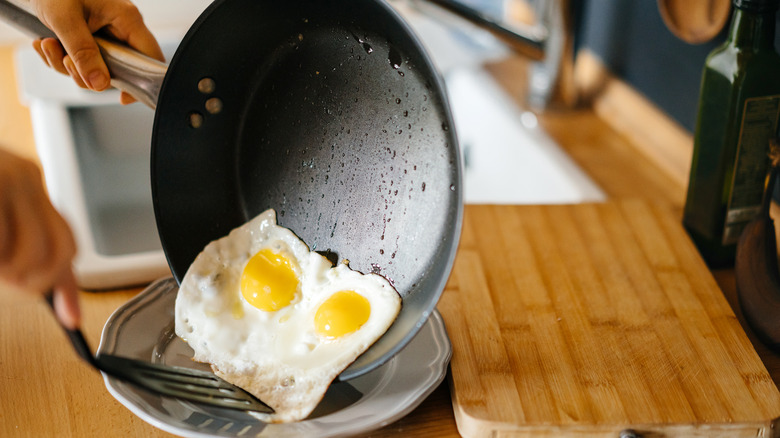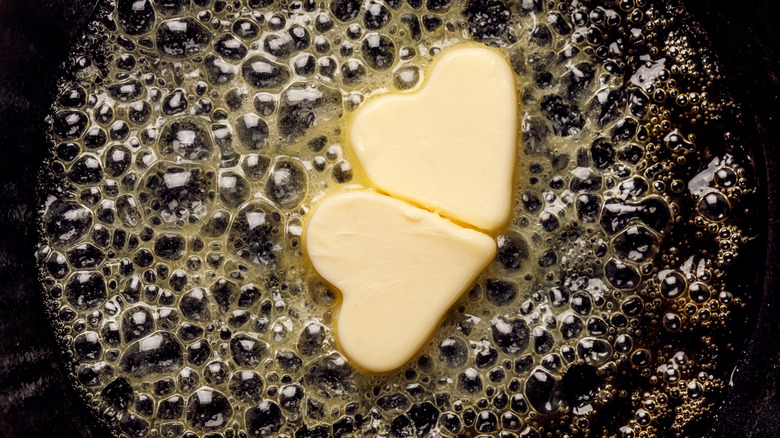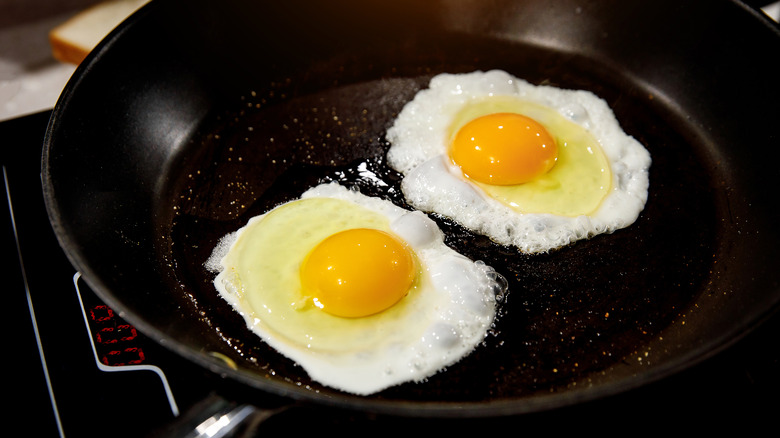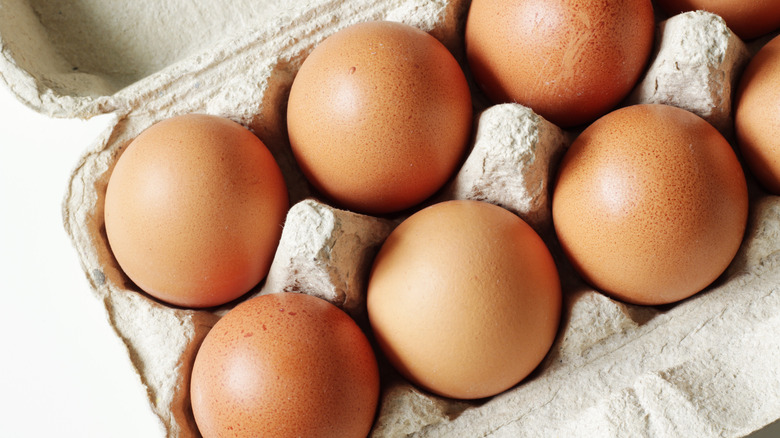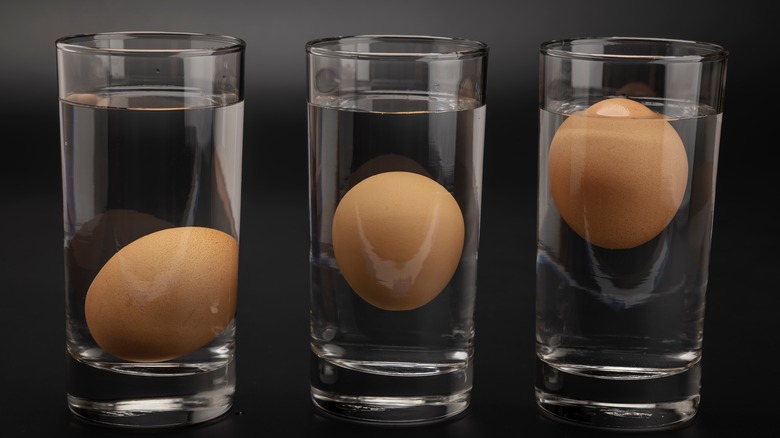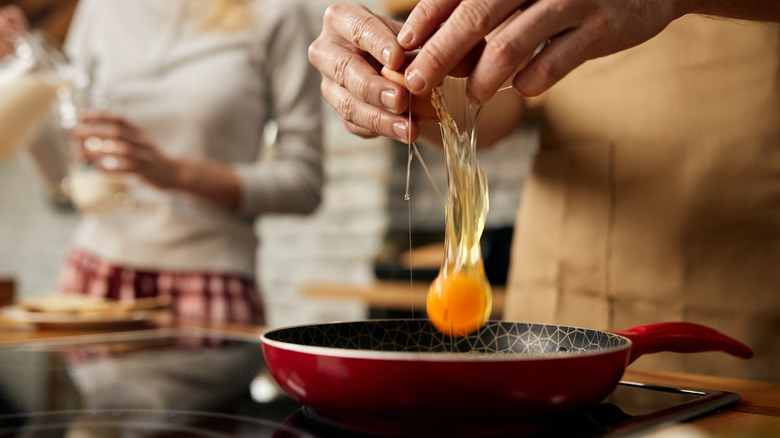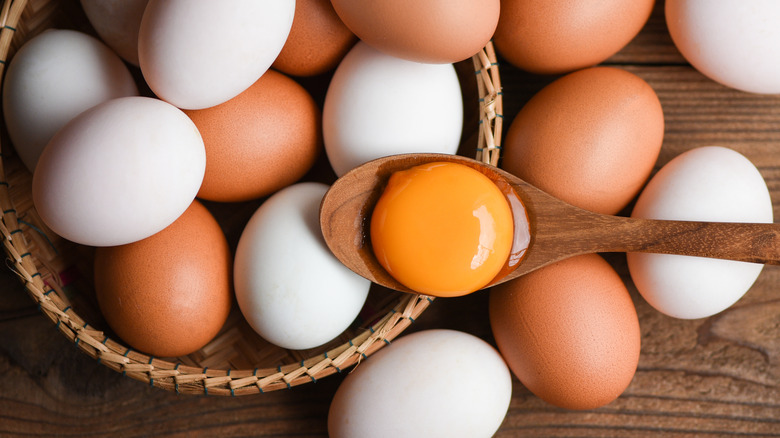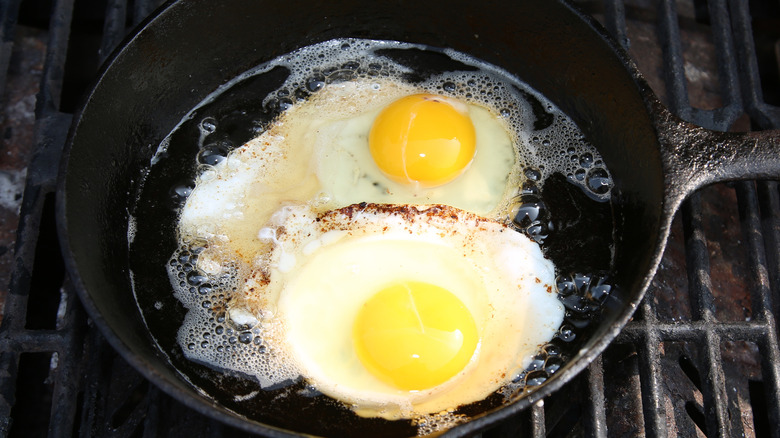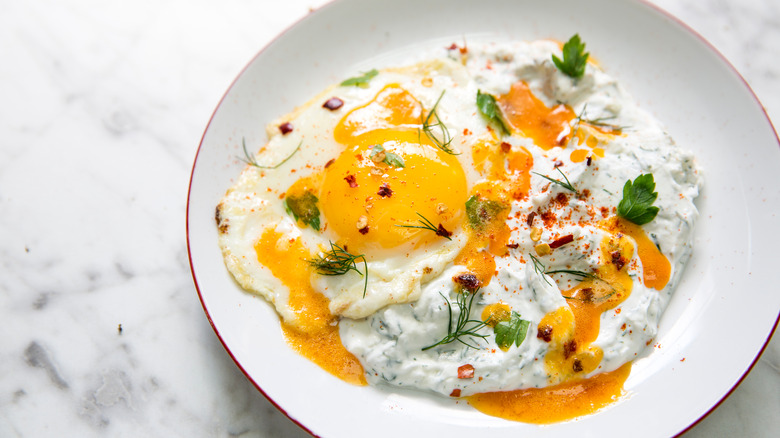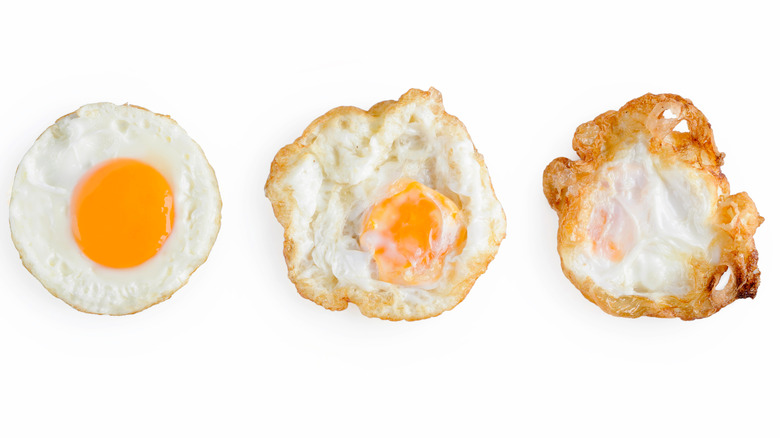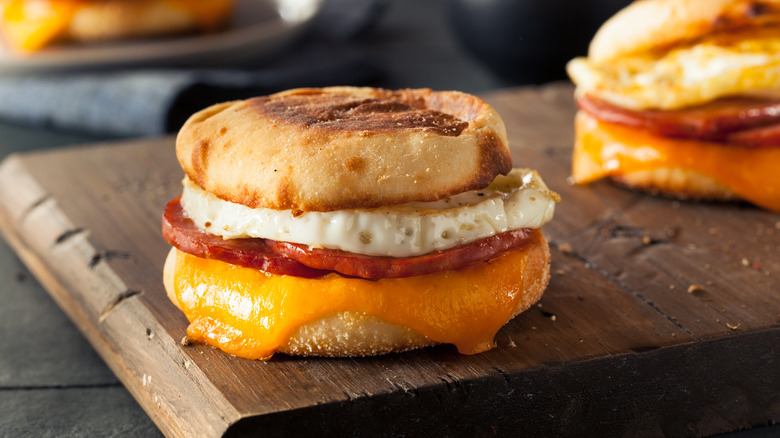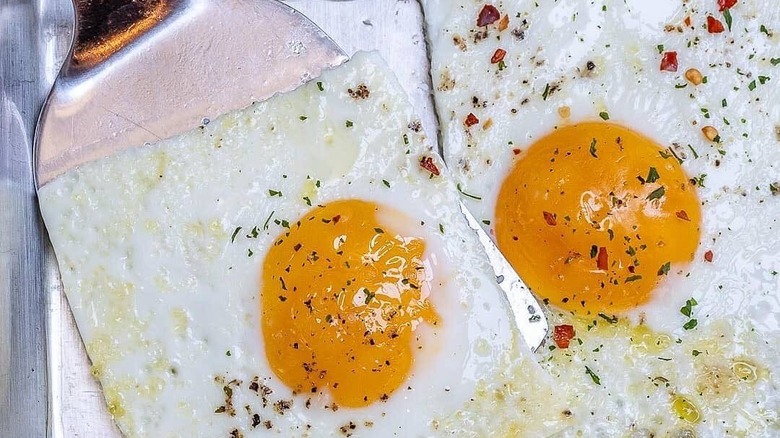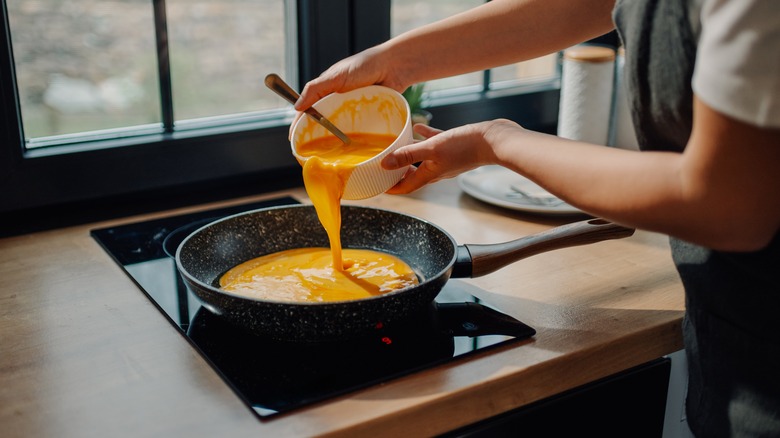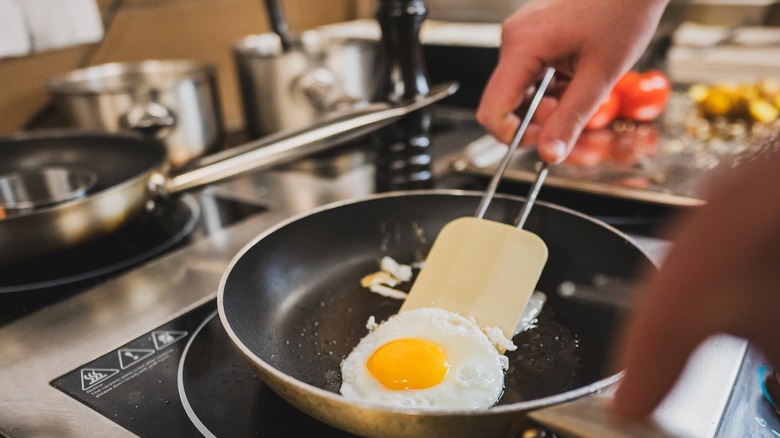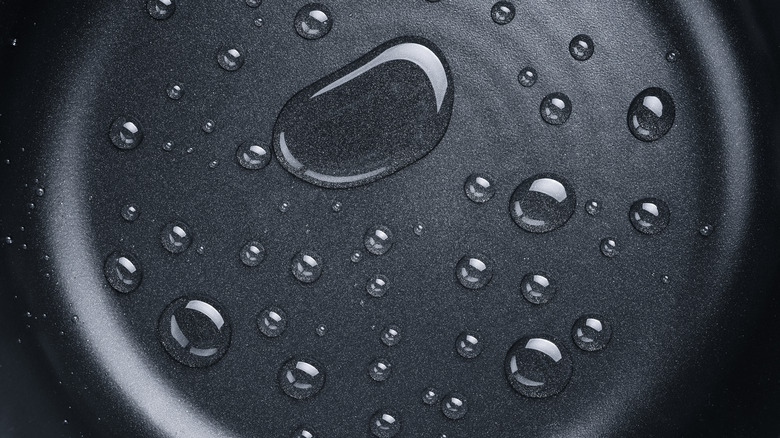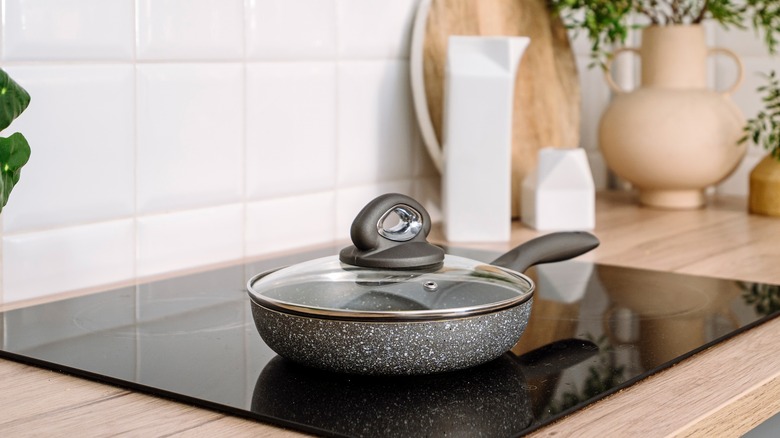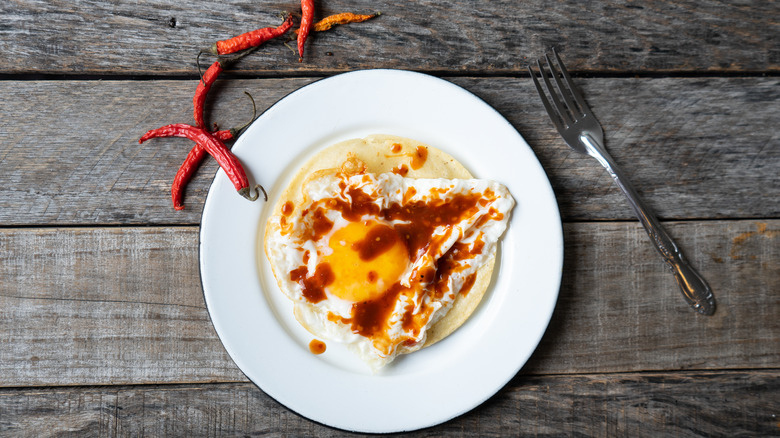Big Mistakes Everyone Makes When Frying Eggs
We may receive a commission on purchases made from links.
It's hard to beat the satisfaction of a perfectly fried egg with its delightfully crispy edges and bright, creamy yolk. And while it's definitely a dish worth mastering at home, the right technique can be frustratingly elusive. There's a long list of ways you can go wrong, and chances are you're making at least one mistake without even knowing it.
But have no fear, because we're here to guide you to make fried eggs more easily than you ever thought possible. We'll walk you through the most common mistakes people make when frying eggs and arm you with the tools you need to avoid them. Stick with us, and you'll be serving up truly egg-cellent eggs in no time for Sunday brunch, weekday breakfasts, and every occasion in between. And now that we've gotten that egg pun out of our system, we promise you won't have to endure any others to come.
Using the wrong pan
If you use the wrong type of pan to fry an egg, you're setting yourself up for failure from the start. Luckily, you can avoid this common mistake by opting for a quality non-stick or well-seasoned cast iron. That way, your fried eggs don't stick and fall apart when you take them out of the pan — a surefire way to ruin the final product.
The reason it matters is that "most pans, even the really good ones, are actually filled with little cracks and crevasses," Joseph Provost, a chemistry and biochemistry professor at the University of San Diego explains to The Washington Post. When the pan gets hot, the metal expands and the liquid from your eggs gets trapped in those cracks. Cue the sticking.
A non-stick pan solves this problem because it puts a smooth, seamless barrier between the metal of the pan and the eggs as they cook. Two of our top picks are the Zwilling Madura Nonstick Fry Pan (Bon Appétit compares it to "a greased-up air hockey table") and the OXO Good Grips Non-Stick Pro Frying Pan. Both are made to be extra durable and corrosion-resistant, important qualities when you're investing in a good non-stick.
Frying eggs in cast iron works, too, but we mean it when we say the pan needs to be well seasoned. If that thing is getting rusty, put it down and learn how to properly season it pronto.
Not frying eggs in fat
If you want to make the perfect fried egg, you're going to want to fry it in some kind of fat. Not only does fat impart loads of flavor, but it also acts as a physical barrier between the eggs and the bottom of the pan to stop them from sticking, per The Washington Post. This can often save your fried eggs whether you're using a non-stick or not.
While any kind of fat will do, including olive oil and bacon grease, Harold McGee, author of "Keys to Good Cooking: A Guide to Making the Best of Foods and Recipes," recommends butter because it "carries anti-sticking emulsifiers." This can be especially helpful with eggs, as their high-protein content makes them more prone to sticking because heat causes proteins and carbohydrates in food to form bonds with a pan's surface.
Another fat we like to use for frying eggs is heavy cream. We know it might sound a little weird, but hear us out. Cream is rich in butterfat and in a way, acts like liquid butter because it breaks down into buttermilk and butterfat as it cooks. In the end, you get fried eggs that are gently steamed and crispy around the edges, with an extra bit of flavor similar to browned butter.
Beginning before the pan is hot enough
It's nearly always best to use a hot pan to fry your eggs. In fact, you should follow this advice for most food that you're looking to fry, sear, or crisp. According to Science of Cooking, when food hits a hot pan it will start to sear almost immediately, releasing small amounts of water and creating a tiny layer of steam that literally lifts it from the bottom of the pan, preventing it from sticking.
If you're frying in fat, which again we think you should, add it once the pan is hot and let it heat up for a few more seconds before introducing the eggs. This will create those perfectly crispy edges you're looking for. Butter melts quickly, and you'll know it's hot enough to add the eggs when the foam subsides, per Cook's Illustrated. Oil, on the other hand, will shimmer ever so slightly when it's ready to go.
It's nearly always best to use a hot pan, but the exception to this rule is if you're frying your eggs in heavy cream. For that method, you'll want to pour the cream into a cool pan and add the eggs, then turn on the heat and bring the cream to a boil (via Food52).
Not using room temperature eggs
Another pro tip is to let your eggs come to room temperature before you crack them. According to The Guardian, starting with a cold egg causes the whites to take longer to set which means you risk overcooking the yolk (which in our opinion is a fried egg disaster). Food Network veteran Robert Irvine swears by this method, explaining on Twitter that really all foods should be room temperature when we cook them so that "when they hit high temp they don't steam." While some steam created by the food as it starts to sear in a hot pan is good, too much means losing the crispy edges that make a fried egg so pleasant.
So, how long do eggs take to come to room temperature? According to Food Network, it depends on the temperature of your kitchen, but on a cold winter morning it can take up to two hours. Thankfully, there's a solution if the hankering for a fried egg hits you out of nowhere. You can bring eggs to room temperature in just five minutes by placing them in a bowl of very warm tap water. Just make sure it isn't too hot or you'll start cooking your eggs before you even get them in the pan. Alternately, if you have the foresight to think about it the night before, baker extraordinaire Duff Goldman tells People that you can leave eggs out overnight (room temperature eggs are best for baking, too).
Using old eggs
The Guardian indicates that fresher eggs are more suitable for frying because the proteins are stronger and hold together better. As chef Yasmeen AlSawwaf explains to Eat This, Not That, "When an egg ages, the whites and yolk thin out. This means that the white will spread instead of being compact and thick and the yolk won't sit atop the whites perfectly." While we're on the topic, Taste of Home asserts that fresh eggs are also best for omelets and scrambled eggs. They're great for baking too, although it matters less. Older eggs, on the other hand, are better for preparations like meringues and hard-boiled eggs (the latter because they're easier to peel).
You can tell how fresh your eggs are with a simple float test. Carefully drop the egg into a bowl of water and see what it does. If it sinks to the bottom and lands horizontally, then it's super fresh, whereas an egg that floats to the top is rotten. Toss that thing straight in the trash. But what if your egg lands somewhere in between, sinking and drifting slowly toward the middle of the bowl (but not floating all the way to the top) or standing vertically on the bottom? If it isn't expired, you don't have to trash it –- just use it for baking or hard boil it.
Cracking the egg on the lip of the pan
You might think cracking an egg is straightforward. Just smack it on the lip of your frying pan and dump it in. But there is a better way to do it, and it doesn't include any fancy one-handed flourishes. Instead, simply give it a quick, confident tap on a flat surface like a cutting board or counter, then gently press your thumbs into the crack you've made to break the membrane and let the egg slide out (via The Kitchn). It might feel counterintuitive, but this method is less likely to break the yolk or split the eggshell into multiple pieces, whereas cracking an egg on the lip of a pan or bowl actually pushes the shell back into the egg (increasing your chances of a runaway shard).
Bobby Flay, a goldmine of cooking tips, also recommends cracking each egg into a bowl before adding it to the pan rather than cracking it straight in. This gives you a chance to remove any stray shell pieces and makes it easier to get an evenly shaped fried egg. Not only do evenly shaped eggs look picture perfect, but they also cook more uniformly so you're more likely to get the ideal balance between set whites and a still-creamy yolk.
By the way, getting eggshell pieces out of your egg is much easier with wet fingertips or half an eggshell than it is with anything else.
Accidentally breaking the yolk
The most satisfying part of a perfectly fried egg is breaking into the deliciously creamy, dreamy yolk –- but the goal is for that to happen on the plate, not in the pan. Luckily, we've already set you up for success.
Proper egg cracking technique is crucial, as is first breaking your eggs into a bowl so they glide into the pan rather than smacking it with a splatter. Being able to flip the eggs is critical, and an egg that doesn't stick allows you to slide a spatula underneath. Thank goodness you're already using a non-stick pan and fat to fry! MasterClass recommends carefully lifting the egg up before tipping the spatula slowly (but deftly and with confidence!) until the uncooked corner of the egg touches the pan, and then laying it carefully yolk-side down. Another option is to avoid the flip altogether by making your eggs sunny side up.
Not basting the eggs as they fry
Once your eggs hit the pan, Tasty warns against moving them while they sizzle, crisp, and cook. But that doesn't mean you should back away from the stove. In fact, this is your chance to take your fried eggs from good to great. How? By basting them in butter (or oil, heavy cream, or bacon grease), per The Kitchn's recommendation. Not only does this add tons of delicious, complex flavor, but it also helps your fried eggs cook evenly without requiring a flip.
All you need for basting is a wide spoon (just don't forget to use a wooden or heat-resistant silicone spoon if you're using a non-stick pan). Then, as the eggs are frying, tip the pan slightly toward you so the butter or whatever fat you're using pools at the edge. Dip your spoon into that liquid gold and ladle it gently and continuously over the eggs as they cook (being careful not to break the yolk) until the whites are just set. You'll be so impressed with the results that you'll wonder why you ever fried an egg any other way.
Not using paprika to season
Paprika might just be the best-kept secret to a perfect fried egg. Commit it to memory and use it often. The trick is to add the paprika to whatever fat you're using before you add the eggs, in order to allow the spice to toast and deepen in flavor. Then, when the paprika becomes fragrant and turns a beautiful dark red color, add your eggs and baste them continuously as they cook to infuse the rich flavors.
Now that you're sold, let's talk about paprika. There are three kinds — sweet, smoked, and hot — and you can use any one of them depending on the flavor you want. Sweet paprika is, obviously, the sweetest. It isn't spicy at all and instead, lends a mild warm taste. Smoked paprika has a little bit of heat and a more complex flavor, while still being fragrant and subtle. Hot paprika packs the biggest punch and while it comes in varying heat levels, it can reach up to 1,000 units on the Scoville scale (a measure of pepper spiciness, named for the man who invented it, Wilber Scoville), which is similar to a poblano or ancho pepper.
Cooking over the wrong heat
If you've ever been told to fry eggs over low heat to set the whites without overcooking the yolks, forget that advice immediately. According to the Food Network, frying eggs over medium-high heat is essential to obtain crispy, irresistible edges – so don't be afraid to turn it up (within reason, of course).
Tasty describes that a sunny-side up egg is cooked to perfection when the whites start to bubble up and are nearly set, the edges are golden brown, and the yolk is bright yellow and still a little runny. Give the pan a gentle shake to see; the yolks should jiggle but the whites should not. And, if you've followed all our non-stick tips, the eggs should slide right off the pan when they're done!
If you're making your fried eggs over easy, over medium, or over hard instead of sunny-side up, you'll want to give them a flip. For over easy eggs, the name of the game is set whites with very runny yolks. Taste of Home notes that it typically takes about 30 seconds of post-flip frying. For over medium eggs, you're looking for set whites with a firmer, yet slightly runny yolk that feels fairly firm to the touch. These take about a minute of post-flip frying. And finally, if you want over hard eggs with yolks that are fully cooked through, you'll want to fry them for another two to three full minutes after flipping the eggs over.
Not trying an egg ring
Ever wondered how places like McDonald's make perfectly round eggs for your breakfast sandwich? Get yourself an egg ring and you can do it too. Egg rings are exactly what they sound like –- rings made for cooking eggs. Invented by Herb Peterson, the creator of the Egg McMuffin himself, with the help of a local blacksmith in 1971 per Good Food Journey, egg rings are typically about three inches in diameter and made to sit directly in your frying pan.
Just place them in, heat the pan, and pour the egg into the ring. Chicago Tribune recommends cracking each egg into a small glass bowl before pouring it into the ring for a smoother, less mess-prone method. Once the egg is cooked through to your preference, simply remove the ring with a pair of tongs and use a spatula to take it out of the pan.
And, since egg rings are one of those cooking utensils that have such a specific purpose they can feel hard to justify if you don't eat eggs all the time or have a kitchen with ample storage space, you better believe we have a hack. Just use the ring from a mason jar lid; it works exactly the same way, but remember to grease the inside before you use it so the eggs don't stick.
Never using a sheet pan
If you need to whip up a killer breakfast for multiple people at once (hello Sunday brunch), sheet pan fried eggs will truly change your life. As family recipe blogger Susan Olayinka of The Flexible Fridge tells Mashed, sheet pan eggs let you make 10 to 12 eggs at a time instead of the typical one to two. And, let's be real, a sheet pan full of sunny-side up eggs also looks super cool –- always a bonus when you're cooking for a crowd.
Step one is to preheat your oven and your sheet pan. Spray the pan with oil, turn your oven to 475 degrees, and stick the pan inside to heat. A hot pan will allow the eggs to cook more quickly and make them less likely to stick. Sound familiar? It should because it's the same advice we recommend for a frying pan!
Next up, grab a dozen eggs. Crack them all into a bowl with a lip made for pouring and then, once the oven is preheated and the pan is hot, carefully tip your eggs out onto your hot pan. Add your seasonings (we like sea salt, freshly cracked black pepper, and a dash of paprika) and pop that baby back in the oven. Bake for just five minutes, then slice the eggs into squares, one yolk each, and serve them right away so they won't keep cooking in the pan.
Using the wrong size pan
Not only is the type of pan that you use important for perfect egg frying, but the size is also going to impact the result. A pan's size affects the heat distribution, as well as the cooking time. Using a frying pan that is too large can cause excessive evaporation, and missing moisture means the potential for dry food. In the case of frying eggs, a large pan may allow your eggs the space to spread too thin and get overcooked. Subsequently, a pan that is too small can lead your eggs to cook unevenly and stick while flipping.
The deciding factor for your pan size choice is your food quantity. Larger pans can cook a bigger amount of eggs at a time, but a smaller frying pan can be a good choice for frying an egg in a single serving. If you find yourself only needing to fry one egg in a sitting, try a 5-inch frying pan. The 8-inch pan can typically fry up to two eggs without overcrowding the eggs, ensuring even cooking. And if you make three to four eggs at a time, a larger pan option like a 12-inch frying pan is your best bet. It should be noted that your egg preparation method could change the pan size recommendations. A preparation like an omelet that still requires flipping needs ample space (but not too much space and risk the egg's texture being compromised).
Using the wrong spatula
There is a certain art and technique to flipping a fried egg perfectly. But equally as important is your tool of choice for flipping. Not all spatulas are one and the same. You will find a thinner spatula capable of getting underneath the egg to get a full flip. If the spatula is too thick, you may find that you push the egg onto itself, folding the egg whites and potentially cracking the yolk. Another possibility is tearing your egg whites while trying to get your spatula under the egg — while that may not affect the actual egg taste, you would lose the picture-perfect fried egg.
The diner-style recommendation is a thin, square or rectangular metal spatula that is greased to prevent sticking. But if you are using a nonstick pan, you run the risk of scratching it with metal. In that case, a silicone or plastic spatula can be a good option. Just be sure it is thin enough to get under the egg to get that perfect flip. There are also other spatula options that have a slanted design to lift the eggs from the pan easier.
Not using water
If your over-easy egg falls victim to the flip every time, this tip is for you. There is a way to get an over-easy egg that eliminates the flipping process (you heard us right). The secret technique is to just add water. That may not sound right, but adding hot water to the pan can create a perfectly cooked over-easy egg without the flipping motion. To employ this cooking technique, start the cooking process per usual by adding a small amount of oil to a pan over medium heat and cracking the egg. After about 30 seconds, add hot water to the pan and baste the eggs until you see the egg whites start to set. The yolk should still be runny, and the egg is cooked evenly — even to the edges — within five minutes.
If you aren't convinced to try out adding water to your eggs during cooking, there are some other benefits to consider. This method uses less oil, as water brings moisture. You can also cook more eggs at once without worrying about sticking, making it more convenient than making each person's egg to order for larger groups.
Leaving your pan uncovered
Another tactic to get your fried egg cooked correctly deals with your pan's temperature. You may think you need a high heat to get those perfectly crisp edges around your egg, but in reality, lower heat is the way to go. But an imperative step in the low-heat cooking method is to cover your pan while the eggs cook. Using that lid keeps the heat and steam inside the pan to ensure your egg is evenly cooked both on the top and the bottom — without being forced to flip. Leaving your egg uncovered means a longer cook time, allowing for the bottom to cook faster than the top. As a result, you may end up with an overcooked egg white while you wait for the yolk to catch up.
The timing of when you grab that lid is also important. You will want to cover your pan immediately after the egg is in the pan. Once your egg appears to be almost done, remove your pan from the heat — but don't touch that lid! The egg will finish up cooking from the residual heat. Taking your pan off the burner prevents overcooking, as you aren't on a direct heat source anymore. The exact timing is determined by how you like your eggs, so keep a close eye on when to pull that pan.
Not using sauces to amplify flavor
Cooking and flipping the fried egg can be a battle in itself. After going through all the effort to get your fried eggs to your plate, the last thing you want is a lackluster flavor. While seasoning the eggs themselves during cooking is a given, there are plenty of creative ways to take your fried eggs to the next level. A play on a love-it-or-hate-it dish like scrambled eggs with ketchup can be elevated with a sriracha and ketchup combination. Hot sauce is a no-brainer if you like spice, whether it be something more classic like Tabasco, akin to huevos rancheros, a fresh salsa, harissa for a North African flair, or an Asian-style sambal. Some salty options include soy sauce or Worcestershire sauce. There are even some savory and sweet sauce options out there, like a pepper jelly or barbecue sauce.
The best part is that you can customize your eggs to your liking — or even your guests' liking if you offer multiple sauce topping options. There may even be flavor profiles out there that you haven't discovered yet.
